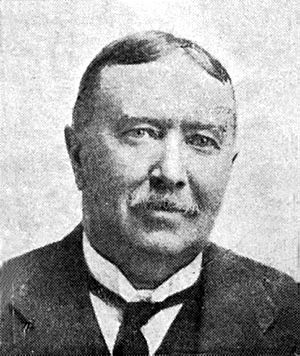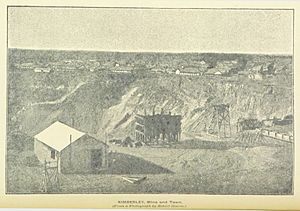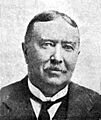Charles Coghlan (politician) facts for kids
Quick facts for kids
The Honourable Sir
Charles Coghlan
|
|
|---|---|

Coghlan, photographed as Premier c. 1925
|
|
| 1st Premier of Southern Rhodesia | |
| In office 1 October 1923 – 28 August 1927 |
|
| Monarch | George V |
| Preceded by | Sir Francis Chaplin (Administrator) |
| Succeeded by | Howard Unwin Moffat |
| Member of Southern Rhodesian Legislative Assembly | |
| In office 29 April 1924 – 28 August 1927 |
|
| Succeeded by | Allan Ross Welsh |
| Constituency | Bulawayo North |
| Member of Southern Rhodesian Legislative Council | |
| In office 24 April 1908 – 29 April 1924 Serving with
|
|
| Preceded by |
|
| Constituency | Western |
| Personal details | |
| Born |
Charles Patrick John Coghlan
24 June 1863 King William's Town, British Kaffraria (today South Africa) |
| Died | 28 August 1927 (aged 64) Salisbury, Southern Rhodesia |
| Resting place | Matopos Hills, Rhodesia |
| Political party | Rhodesia Party |
| Spouse |
Gertrude Mary Schermbrucker
(m. 1899–1927) |
| Children | 2 |
| Alma mater | South African College, Cape Town |
| Profession | Lawyer, politician |
Sir Charles Patrick John Coghlan (born 24 June 1863 – died 28 August 1927) was an important lawyer and politician. He became the first Premier (like a Prime Minister) of Southern Rhodesia on 1 October 1923. He held this role until he passed away in 1927.
Coghlan was a key leader in the "responsible government" movement. This movement wanted Southern Rhodesia to govern itself. Thanks to his efforts, Southern Rhodesia became a self-governing colony within the British Empire. This meant it could make its own laws, but was still part of the British Empire.
Born and raised in South Africa, Coghlan moved to Bulawayo in 1900 to work as a lawyer. He was elected to the Southern Rhodesian Legislative Council in 1908. He later became a Member of the Southern Rhodesian Legislative Assembly for Bulawayo from 1924 until his death.
Contents
Who was Charles Coghlan?
Early Life and Education (1863–1882)
Charles Patrick John Coghlan was born on 24 June 1863. His birthplace was King William's Town, which was then part of British Kaffraria (now in South Africa). His father, James Coghlan, was from Ireland and had moved to South Africa in 1851. His mother, Isabella Mary, was from Scotland.
Charles was taught at home until 1870. Then, he went to St Aidan's College in Grahamstown. He later won a scholarship to study law at the South African College in Cape Town. However, his father died in 1882, and Charles had to leave university early. He started working at a law firm in Kimberley with his eldest brother, James.
Life in Kimberley (1882–1900)
Kimberley was a busy town known for its diamond mines. Charles Coghlan became a lawyer there in 1886. He and his brother formed their own law firm, Coghlan and Coghlan. They became experts in mining law.
During this time, Cecil Rhodes gained control of the diamond mines. He also formed the British South Africa Company (BSAC). This company was given permission by Queen Victoria to govern and develop lands in what became Rhodesia.
Coghlan was very interested in public discussions. He believed that all parts of the British Empire should be able to govern themselves. He even supported the idea of "Home Rule" for Ireland, his family's homeland. He also disagreed with the government of the South African Republic, which treated British settlers unfairly.
In 1897, Coghlan was elected to the Kimberley town council. He married Gertrude Mary Schermbrucker in 1899. Around this time, he thought about moving to Bulawayo in Rhodesia. But the Second Boer War started in October 1899. Kimberley was under attack, so he had to stay there until 1900.
Moving to Bulawayo (1900–1908)
After the war, Coghlan and his wife moved to Bulawayo on 30 July 1900. Life there was quite basic at first. They had their first child in 1901, but sadly, the baby lived only three days. Their second child, a daughter named Petal, was born in 1902 and lived a long life.
Coghlan continued his law career in Rhodesia. He formed a new law firm called Coghlan and Welsh. This firm grew and opened an office in Salisbury in 1907. In 1908, Coghlan successfully ran for election to the Southern Rhodesian Legislative Council.
Working for Self-Government (1908–1922)
Many people expected Southern Rhodesia to join the Union of South Africa. Coghlan initially thought this would happen eventually. However, he believed Southern Rhodesia should first have "responsible government." This meant it would manage its own affairs while still being a British colony.
Coghlan became worried about how the Union of South Africa treated British people. By 1910, he felt that Southern Rhodesia joining the Union was not going to happen soon. He also disagreed with the idea of keeping Rhodesia only for English-speaking settlers.
During the First World War, white people in Rhodesia were divided. Some wanted to join South Africa (Unionists). Others, led by Coghlan, wanted self-government (Responsible Government Association). The British government and the BSAC preferred Rhodesia to join South Africa. This was because South Africa would then have to pay for the BSAC's assets.
Despite strong opposition, Coghlan and the Responsible Government Association worked hard. They campaigned for self-government. In the 1922 Southern Rhodesian government referendum, people voted on whether to join South Africa or become self-governing. The results were 8,774 votes for responsible government and 5,989 for joining South Africa. Women played a big role in this vote, with about 75% of them choosing self-government.
Becoming Premier (1923–1927)
After the referendum, Sir Charles Coghlan became the first Premier of Southern Rhodesia on 1 October 1923. Before this, he had not wanted Southern Rhodesia to combine with Northern Rhodesia. He thought it would make self-government harder to achieve.
As Premier, Coghlan started to think about expanding Southern Rhodesia's territory. He wanted to claim parts of Bechuanaland (now Botswana) and Northern Rhodesia (now Zambia). He was especially interested in Northern Rhodesia's rich copper deposits. He also wanted control of the railway to help with trade and to attract workers for mines and farms.
Coghlan asked Britain's Colonial Secretary, Leopold Amery, to give Northern Rhodesia to the South. However, Amery refused this request. After Coghlan's death, Britain decided to keep Northern Rhodesia separate.
Death and Legacy
Sir Charles Coghlan passed away on Sunday, 28 August 1927, at the age of 64. He died from a brain haemorrhage. He was first buried in Bulawayo. Later, he was reburied in the Matopos Hills, near the graves of Cecil Rhodes and Sir Starr Jameson. This ceremony took place on 14 August 1930.
Sir John Chancellor, the first Governor of Southern Rhodesia, praised Coghlan's work. He said that under Coghlan's leadership, Southern Rhodesia made great progress. The country's economy grew, with its income increasing from £1.3 million to £2 million. Exports also went up from £8.5 million to £12 million.
A building in Zimbabwe was once named after Sir Charles Coghlan. However, in 1985, its name was changed to Chaminuka.
Honours
Coghlan was knighted in 1910. This honour was for his work at the 1908 National Convention. This meeting led to the South Africa Act 1909 and the creation of the Union of South Africa.
In 1925, he received another important honour, the KCMG. This stands for Knight Commander of the Order of St Michael and St George.
Images for kids






